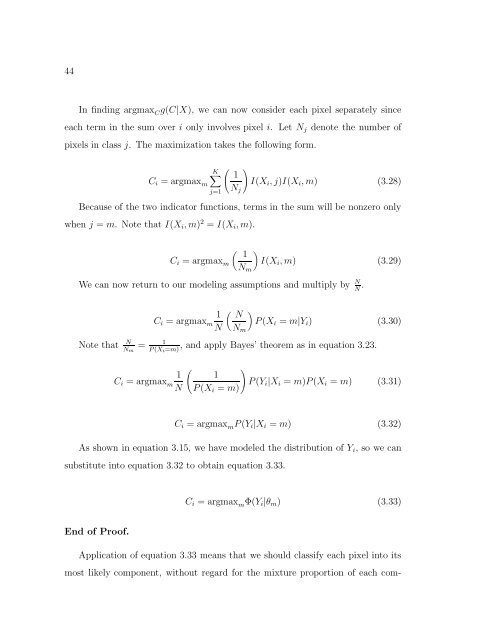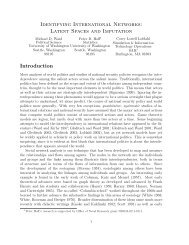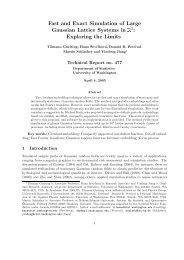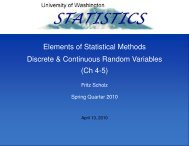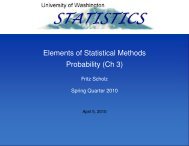- Page 1:
Fast Automatic Unsupervised Image S
- Page 5:
In presenting this dissertation in
- Page 9 and 10:
TABLE OF CONTENTSList of FiguresLis
- Page 11 and 12:
4.1.2 Penalty Adjustment . . . . .
- Page 13 and 14: Appendix A: Software Discussion 169
- Page 15 and 16: 4.1 (a) Signal generated by an AR(1
- Page 17 and 18: 5.29 Aerial image of a buoy, before
- Page 19: DEDICATIONThis work is dedicated to
- Page 22 and 23: 20 10 20 30 40 50 600 10 20 30 40 5
- Page 24 and 25: 4fast because they can be implement
- Page 26 and 27: 6multidimensional observations at e
- Page 28 and 29: ••••8Figure 2.1(a) is a sim
- Page 30 and 31: 10Principal Curve•••••Dat
- Page 32 and 33: 12based on the estimates of the par
- Page 34 and 35: 14first of these can be done by a h
- Page 36 and 37: 162.4 Examples2.4.1 A Simulated Two
- Page 38 and 39: 18Figure 2.5: HPCC applied to the t
- Page 41 and 42: 21Table 2.2: BIC results for simula
- Page 43 and 44: 232.4.3 New Madrid Seismic RegionDa
- Page 45 and 46: 25Table 2.3: BIC results for New Ma
- Page 47 and 48: 27Latitude35.5 36.0 36.5 37.0 37.5
- Page 49 and 50: 29set, so we want to avoid assumpti
- Page 51 and 52: 31The examples we have presented in
- Page 53 and 54: Chapter 3MARGINAL SEGMENTATIONIn th
- Page 55 and 56: 35about ˜θ; this is a good approx
- Page 57 and 58: 373.2 Mixture ModelsThe mixture den
- Page 59 and 60: 39for estimating the model paramete
- Page 61 and 62: 41The ith pixel of X or C is denote
- Page 63: 43In componentwise classification,
- Page 67 and 68: Chapter 4ADJUSTING FOR AUTOREGRESSI
- Page 69 and 70: 49Dependence CaseWhen |β| < 1, the
- Page 72 and 73: 52For practical purposes, equation
- Page 74 and 75: 54g ′′ (θ) ≈⎛⎜⎝∑ Ni=
- Page 76 and 77: 564.1.3 Computing BIC with the AR(1
- Page 78 and 79: 58upper, left, and right borders of
- Page 80 and 81: 60L(Y −B |M, B) = L IND (Y −B |
- Page 82 and 83: 62We now return to equation 4.56 an
- Page 84 and 85: 64and then computing a mean-correct
- Page 86 and 87: 66regression, which can be written
- Page 88 and 89: 68resulting R 2 values are 0.93 for
- Page 90 and 91: 700 5 10 15 200 5 10 15 20Figure 4.
- Page 92 and 93: 72negative value would mean that ne
- Page 94 and 95: 74Once each pixel has been updated,
- Page 96 and 97: 76The basic idea of this psuedolike
- Page 98 and 99: 78The consistency result presented
- Page 100 and 101: 80⎛∑ ⎞Kj=1f(Yg i (Y i ) = log
- Page 102 and 103: 82| log(f(Y i |X i = S, θ 1 ))|
- Page 104 and 105: 84⇒ (L ˆX (Y |K)) exp(−(D K
- Page 106 and 107: 86the object of the expectation is
- Page 108 and 109: 88Thus, equation 5.42 holds, so BIC
- Page 110 and 111: 90the inequality in equation 5.55 h
- Page 112 and 113: 92N log(σ K ) − N log(σ 1 ) −
- Page 114 and 115:
94final number of clusters. The cho
- Page 116 and 117:
96ization to initialize (see sectio
- Page 118 and 119:
98ˆσ 2 j =∑ Ni=1 ˆQ ij (Y i
- Page 120 and 121:
100one particular data value, which
- Page 122 and 123:
102classification they are not. Eac
- Page 124 and 125:
1045.2.6 Morphological Smoothing (O
- Page 126 and 127:
1065.3 Image Segmentation Examples5
- Page 128 and 129:
1080 10 20 30 400 10 20 30 40Figure
- Page 130 and 131:
1100.0 0.005 0.010 0.015 0.020 0.02
- Page 132 and 133:
112three pixels remain incorrectly
- Page 134 and 135:
114Table 5.3: EM-based parameter es
- Page 136 and 137:
1160 10 20 30 40 50 600 10 20 30 40
- Page 138 and 139:
1180 10 20 30 40 50 600 10 20 30 40
- Page 140 and 141:
1205.3.3 Ice FloesFigure 5.10 shows
- Page 142 and 143:
1220 20 40 60 80 1000 20 40 60 80 1
- Page 144 and 145:
124Percent0.0 0.005 0.010 0.015 0.0
- Page 146 and 147:
1260 20 40 60 80 1000 20 40 60 80 1
- Page 148 and 149:
1280 20 40 60 80 1000 20 40 60 80 1
- Page 150 and 151:
1305.3.4 Dog LungFigure 5.17 presen
- Page 152 and 153:
132Table 5.6: Logpseudolikelihood a
- Page 154 and 155:
134Percent0.0 0.05 0.10 0.15 0.200
- Page 156 and 157:
1360 20 40 60 80 100 1200 20 40 60
- Page 158 and 159:
1380 20 40 60 80 100 1200 20 40 60
- Page 160 and 161:
140interior to the land which had i
- Page 162 and 163:
142Table 5.9: EM-based parameter es
- Page 164 and 165:
1440 20 40 60 80 100 1200 20 40 60
- Page 166 and 167:
1460 20 40 60 80 100 1200 20 40 60
- Page 168 and 169:
1485.3.6 BuoyFigure 5.29 is an aeri
- Page 170 and 171:
150Table 5.10: Logpseudolikelihood
- Page 172 and 173:
1520 20 40 60 80 1000 20 40 60 80 1
- Page 174 and 175:
1540 20 40 60 80 1000 20 40 60 80 1
- Page 176 and 177:
1560 20 40 60 80 1000 20 40 60 80 1
- Page 178 and 179:
Chapter 6CONCLUSIONSThis dissertati
- Page 180 and 181:
160of subsampling would have to be
- Page 182 and 183:
REFERENCESAllard, D., and Fraley, C
- Page 184 and 185:
16494, 555-568.Fraley, C., and Raft
- Page 186 and 187:
166Maps,” Biological Cybernetics,
- Page 188 and 189:
168Zahn, C. (1971), “Graph-Theore
- Page 190 and 191:
170structuring element file.Segment
- Page 192 and 193:
172A.3 Splus codehpcc - Hierarchica
- Page 194:
VITA1993 B.S. Mathematics, Harvey M


